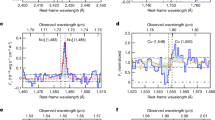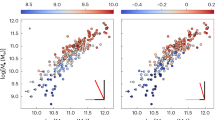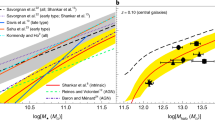Abstract
Supermassive black holes, with masses more than a million times that of the Sun, seem to inhabit the centres of all massive galaxies1,2. Cosmologically motivated theories of galaxy formation require feedback from these supermassive black holes to regulate star formation3. In the absence of such feedback, state-of-the-art numerical simulations fail to reproduce the number density and properties of massive galaxies in the local Universe4,5,6. There is, however, no observational evidence of this strongly coupled coevolution between supermassive black holes and star formation, impeding our understanding of baryonic processes within galaxies. Here we report that the star formation histories of nearby massive galaxies, as measured from their integrated optical spectra, depend on the mass of the central supermassive black hole. Our results indicate that the black-hole mass scales with the gas cooling rate in the early Universe. The subsequent quenching of star formation takes place earlier and more efficiently in galaxies that host higher-mass central black holes. The observed relation between black-hole mass and star formation efficiency applies to all generations of stars formed throughout the life of a galaxy, revealing a continuous interplay between black-hole activity and baryon cooling.
This is a preview of subscription content, access via your institution
Access options
Access Nature and 54 other Nature Portfolio journals
Get Nature+, our best-value online-access subscription
$29.99 / 30 days
cancel any time
Subscribe to this journal
Receive 51 print issues and online access
$199.00 per year
only $3.90 per issue
Buy this article
- Purchase on Springer Link
- Instant access to full article PDF
Prices may be subject to local taxes which are calculated during checkout


Similar content being viewed by others
References
Magorrian, J. et al. The demography of massive dark objects in galaxy centers. Astron. J. 115, 2285–2305 (1998)
Gebhardt, K. et al. A relationship between nuclear black hole mass and galaxy velocity dispersion. Astrophys. J. 539, L13–L16 (2000)
Silk, J. & Mamon, G. A. The current status of galaxy formation. Res. Astron. Astrophys. 12, 917–946 (2012)
Vogelsberger, M. et al. Introducing the Illustris Project: simulating the coevolution of dark and visible matter in the Universe. Mon. Not. R. Astron. Soc. 444, 1518–1547 (2014)
Schaye, J. et al. The EAGLE project: simulating the evolution and assembly of galaxies and their environments. Mon. Not. R. Astron. Soc. 446, 521–554 (2015)
Choi, E. et al. Physics of galactic metals: evolutionary effects due to production, distribution, feedback & interaction with black holes. Astrophys. J. 844, 31 (2016)
Ferrarese, L. & Merritt, D. A fundamental relation between supermassive black holes and their host galaxies. Astrophys. J. 539, L9–L12 (2000)
Crain, R. A. et al. The EAGLE simulations of galaxy formation: calibration of subgrid physics and model variations. Mon. Not. R. Astron. Soc. 450, 1937–1961 (2015)
Sijacki, D. et al. The Illustris simulation: the evolving population of black holes across cosmic time. Mon. Not. R. Astron. Soc. 452, 575–596 (2015)
van den Bosch, R. C. E., Gebhardt, K., Gültekin, K., Yldrm, A. & Walsh, J. L. Hunting for supermassive black holes in nearby galaxies with the Hobby–Eberly Telescope. Astrophys. J. Suppl. Ser. 218, 10 (2015)
Rodriguez-Gomez, V. et al. The stellar mass assembly of galaxies in the Illustris simulation: growth by mergers and the spatial distribution of accreted stars. Mon. Not. R. Astron. Soc. 458, 2371–2390 (2016)
van den Bosch, R. C. E. Unification of the fundamental plane and super massive black hole masses. Astrophys. J. 831, 134 (2016)
Ocvirk, P., Pichon, C., Lançon, A. & Thiébaut, E. STECKMAP: STEllar Content and Kinematics from high resolution galactic spectra via Maximum A Posteriori. Mon. Not. R. Astron. Soc. 365, 74–84 (2006)
Vazdekis, A. et al. Evolutionary stellar population synthesis with MILES—I. The base models and a new line index system. Mon. Not. R. Astron. Soc. 404, 1639–1671 (2010)
Koleva, M., Prugniel, P., Ocvirk, P., Le Borgne, D. & Soubiran, C. Spectroscopic ages and metallicities of stellar populations: validation of full spectrum fitting. Mon. Not. R. Astron. Soc. 385, 1998–2010 (2008)
Sánchez-Blázquez, P., Ocvirk, P., Gibson, B. K., Pérez, I. & Peletier, R. F. Star formation history of barred disc galaxies. Mon. Not. R. Astron. Soc. 415, 709–731 (2011)
Leitner, S. N. On the last 10 billion years of stellar mass growth in star-forming galaxies. Astrophys. J. 745, 149 (2012)
Ruiz-Lara, T. et al. Recovering star formation histories: Integrated-light analyses vs. stellar colour-magnitude diagrams. Astron. Astrophys. 583, A60 (2015)
Beifiori, A., Courteau, S., Corsini, E. M. & Zhu, Y. On the correlations between galaxy properties and supermassive black hole mass. Mon. Not. R. Astron. Soc. 419, 2497–2528 (2012)
Thomas, D., Maraston, C., Bender, R. & Mendes de Oliveira, C. The epochs of early-type galaxy formation as a function of environment. Astrophys. J. 621, 673–694 (2005)
Peng, C. Y. How mergers may affect the mass scaling relation between gravitationally bound systems. Astrophys. J. 671, 1098–1107 (2007)
Jahnke, K. & Macciò, A. V. The non-causal origin of the black-hole-galaxy scaling relations. Astrophys. J. 734, 92 (2011)
Fan, X. et al. A survey of z > 5.8 quasars in the Sloan Digital Sky Survey. I. Discovery of three new quasars and the spatial density of luminous quasars at z = 6. Astron. J. 122, 2833–2849 (2001)
Martin-Navarro, I., Brodie, J. P., van den Bosch, R. C. E., Romanowsky, A. J. & Forbes, D. A. Stellar populations across the black hole mass-velocity dispersion relation. Astrophys. J. 832, L11 (2016)
Terrazas, B. A. et al. Quiescence correlates strongly with directly measured black hole mass in central galaxies. Astrophys. J. 830, L12 (2016)
Bower, R. G. et al. The dark nemesis of galaxy formation: why hot haloes trigger black hole growth and bring star formation to an end. Mon. Not. R. Astron. Soc. 465, 32–44 (2017)
Kauffmann, G. et al. The host galaxies of active galactic nuclei. Mon. Not. R. Astron. Soc. 346, 1055–1077 (2003)
Mullaney, J. R. et al. GOODS-Herschel: the far-infrared view of star formation in active galactic nucleus host galaxies since z ≈ 3. Mon. Not. R. Astron. Soc. 419, 95–115 (2012)
Stanley, F. et al. A remarkably flat relationship between the average star formation rate and AGN luminosity for distant X-ray AGN. Mon. Not. R. Astron. Soc. 453, 591–604 (2015)
Ruschel-Dutra, D., Rodríguez Espinosa, J. M., González Martín, O., Pastoriza, M. & Riffel, R. Star formation in AGNs at the hundred parsec scale using MIR high-resolution images. Mon. Not. R. Astron. Soc. 466, 3353–3363 (2017)
Cappellari, M. & Emsellem, E. Parametric recovery of line-of-sight velocity distributions from absorption-line spectra of galaxies via penalized likelihood. Publ. Astron. Soc. Pacif. 116, 138–147 (2004)
Ocvirk, P., Pichon, C., Lançon, A. & Thiébaut, E. STECMAP: STEllar Content from high-resolution galactic spectra via Maximum A Posteriori. Mon. Not. R. Astron. Soc. 365, 46–73 (2006)
Shimasaku, K. et al. Statistical properties of bright galaxies in the Sloan Digital Sky Survey Photometric System. Astron. J. 122, 1238–1250 (2001)
Courteau, S., McDonald, M., Widrow, L. M. & Holtzman, J. The bulge–halo connection in galaxies: a physical interpretation of the Vc–σ0 relation. Astrophys. J. 655, L21–L24 (2007)
Kormendy, J. & Ho, L. C. Coevolution (or not) of supermassive black holes and host galaxies. Annu. Rev. Astron. Astrophys. 51, 511–653 (2013)
Kuntschner, H. et al. The SAURON project: XVII. Stellar population analysis of the absorption line strength maps of 48 early-type galaxies. Mon. Not. R. Astron. Soc. 408, 97–132 (2010)
Hu, J. The black hole mass–stellar velocity dispersion correlation: bulges versus pseudo-bulges. Mon. Not. R. Astron. Soc. 386, 2242–2252 (2008)
Kormendy, J., Bender, R. & Cornell, M. E. Supermassive black holes do not correlate with galaxy disks or pseudobulges. Nature 469, 374–376 (2011)
Le Borgne, D. et al. Evolutionary synthesis of galaxies at high spectral resolution with the code PEGASE-HR. Metallicity and age tracers. Astron. Astrophys. 425, 881–897 (2004)
Bruzual, G. & Charlot, S. Stellar population synthesis at the resolution of 2003. Mon. Not. R. Astron. Soc. 344, 1000–1028 (2003)
González Delgado, R. M., Cerviño, M., Martins, L. P., Leitherer, C. & Hauschildt, P. H. Evolutionary stellar population synthesis at high spectral resolution: optical wavelengths. Mon. Not. R. Astron. Soc. 357, 945–960 (2005)
González Delgado, R. M. & Cid Fernandes, R. Testing spectral models for stellar populations with star clusters: II. Results. Mon. Not. R. Astron. Soc. 403, 797–816 (2010)
Pietrinferni, A., Cassisi, S., Salaris, M. & Castelli, F. A large stellar evolution database for population synthesis studies. I. Scaled solar models and isochrones. Astrophys. J. 612, 168–190 (2004)
Bernardi, M., Sheth, R. K., Tundo, E. & Hyde, J. B. Selection bias in the M •–σ and M•–L correlations and its consequences. Astrophys. J. 660, 267–275 (2007)
Shankar, F. et al. Selection bias in dynamically measured supermassive black hole samples: its consequences and the quest for the most fundamental relation. Mon. Not. R. Astron. Soc. 460, 3119–3142 (2016)
Saglia, R. P. et al. The SINFONI Black Hole Survey: the black hole fundamental plane revisited and the paths of (co)evolution of supermassive black holes and bulges. Astrophys. J. 818, 47 (2016)
Gültekin, K., Tremaine, S., Loeb, A. & Richstone, D. O. Observational selection effects and the M–σ relation. Astrophys. J. 738, 17 (2011)
Jarrett, T. H. et al. 2MASS Extended Source Catalog: overview and algorithms. Astron. J. 119, 2498–2531 (2000)
Cappellari, M. et al. The ATLAS3D project: I. A volume-limited sample of 260 nearby early-type galaxies: science goals and selection criteria. Mon. Not. R. Astron. Soc. 413, 813–836 (2011)
Acknowledgements
We acknowledge support from the National Science Foundation (NSF) grants AST-1616598 and AST-1616710, from a Marie Curie Global Fellowship, from SFB 881 ‘The Milky Way System’ (subprojects A7 and A8) funded by the German Research Foundation, and from grants AYA2016-77237-C3-1-P and AYA2014-56795-P from the Spanish Ministry of Economy and Competitiveness (MINECO). G.v.d.V. acknowledges funding from the European Research Council (ERC) under the European Union’s Horizon 2020 research and innovation programme under grant agreement no. 724857 (Consolidator Grant ArcheoDyn). A.J.R. was supported as a Research Corporation for Science Advancement Cottrell Scholar. I.M.-N. thanks the TRACES group and M. Mezcua for their comments, R. van den Bosch for making the HETMGS data publicly available and A. Boecker for her help.
Author information
Authors and Affiliations
Contributions
I.M.-N. derived the star formation histories along with T.R.-L. and wrote the text. J.P.B., A.J.R., T.R.-L. and G.v.d.V. contributed to the interpretation and analysis of the results.
Corresponding author
Ethics declarations
Competing interests
The authors declare no competing financial interests.
Additional information
Reviewer Information Nature thanks D. Rosario, J. Trump and the other anonymous reviewer(s) for their contribution to the peer review of this work.
Publisher's note: Springer Nature remains neutral with regard to jurisdictional claims in published maps and institutional affiliations.
Extended data figures and tables
Extended Data Figure 1 Data and best-fitting stellar populations model.
a, The spectrum of the low-σ galaxy NGC 3627; b, the spectrum of the higher-σ galaxy NGC 315. Along with the HETMGS spectra (black line), we also show the best-fitting STECKMAP model (red line). In the bottom panel, we show the residuals (blue dots), which are in both cases below 2%. The standard deviation is shown as dashed horizontal lines.
Extended Data Figure 2 Cumulative mass distributions without fixing the kinematics.
To assess the degeneracy between stellar population properties and stellar velocity dispersion, we repeated the analysis while allowing STECKMAP to fit the kinematics simultaneously with the SFHs. In red and blue, the cumulative mass fractions of under-massive (blue) and over-massive (red) black-hole galaxies are shown as a function of look-back time. Although leaving the kinematics as free parameters leads to less accurate SFHs16, the differences in the star formation of under-massive and over-massive black-hole galaxies remain clear.
Extended Data Figure 3 Robustness of the recovered star formation rates.
Different panels correspond to the different tests performed in order to explore the reliability of our results. As in Fig. 2, red and blue lines indicate the star formation rate (SFR) as a function of look-back time for over-massive and under-massive black-hole galaxies, and the shaded areas mark the 1σ uncertainties. a, Our preferred model, as a reference. A two-sided Kolmogorov–Smirnov comparison between over-massive and under-massive galaxies indicates that the two distributions are significantly different (P = 0.026). b, Here, we left the regularization of the SFH almost free, by setting μx = 0.1. c, We varied the regularization of the age–metallicity relation in the same way, changing μZ from 10 to 0.1. d, Finally, we adopted a different (but inconsistent) M•–σ relation12 to separate our sample. All these tests demonstrate that our conclusions are insensitive to systematics in the analysis.
Extended Data Figure 4 Distributions of concentration parameters.
The distribution of the C28 concentration parameter is shown in red and blue for over-massive and under-massive black-hole galaxies, respectively. Higher (lower) concentration indices are associated with earlier (later) morphological types. Vertical dashed lines mark the median of the distributions. No significant differences are found between the samples, indicating that the over-massive and under-massive black-hole galaxies are morphologically indistinguishable. This suggests that both types of galaxy share the same formation processes but differ in the present-day mass of their central black holes.
Extended Data Figure 5 Star formation rate for high-mass galaxies.
Differences in the star formation rate as a function of look-back time for over-massive (red) and under-massive (blue) black-hole galaxies, but only including objects with velocity dispersions σ > 200 km s−1 (logσ = 2.32). The massive end of the M•–σ relation is dominated by elliptical, pressure-supported systems12,19 but shows the same distinction between over-massive and under-massive black-hole galaxies.
Extended Data Figure 6 Nebular emission and star formation rate.
If we include galaxies with strong emission lines in the analysis, the quality of the fits worsens but over-massive (red) and under-massive (blue) black-hole galaxies still show decoupled SFHs.
Extended Data Figure 7 Dependence on the stellar population models.
As in Fig. 2, each panel shows the cumulative mass fraction for over-massive (red) and under-massive (blue) black-hole galaxies. In each panel, the SFHs were calculated using a different set of stellar population synthesis models. a, Result based on the PÉGASE-HR39 models; b, result based BC03 model40; c, result using the GRANADA/MILES models41,42; d, finally, result using the MILES models with BaSTi isochrones43. Despite the quantitative differences, the different behaviour of under-massive and over-massive black-hole galaxies is clear in all panels, and thus it is not an artefact of a particular set of models. Note that different models are fed with different stellar libraries, interpolated in different ways to populate different isochrones. The separation between over-massive and under-massive black-hole galaxies is thus independent of the different ingredients in stellar population modelling.
Extended Data Figure 8 Stellar density as a confounding variable.
a, M• as a function of the best-fitting combination of σ and stellar density, following equation (1). Projecting over this plane allows us to separate galaxies depending on the mass of their black holes, but at fixed stellar velocity dispersion and stellar density ( ). b, The cumulative mass distributions of over-massive and under-massive black-hole galaxies according to this new definition. This test demonstrates that the observed differences in the SFHs are not due to a possible variation of the stellar density across the M•–σ relation, further supporting the role of the black hole in regulating star formation within massive galaxies.
). b, The cumulative mass distributions of over-massive and under-massive black-hole galaxies according to this new definition. This test demonstrates that the observed differences in the SFHs are not due to a possible variation of the stellar density across the M•–σ relation, further supporting the role of the black hole in regulating star formation within massive galaxies.
Extended Data Figure 9 Selection function.
Filled grey squares show the size–σ relation for the HETMGS sample, and filled circles correspond to those galaxies with measured black-hole masses (blue and red indicate under-massive and over-massive, respectively), which are, on average, more compact than the overall population. However, we found no differences in the mean sizes of our final sample of galaxies (both over-massive and under-massive), compared with the total population of galaxies with known black-hole masses (filled circles). Thus, our results are not driven by our rejection criteria in terms of signal-to-noise ratio or emission-line contamination.
PowerPoint slides
Rights and permissions
About this article
Cite this article
Martín-Navarro, I., Brodie, J., Romanowsky, A. et al. Black-hole-regulated star formation in massive galaxies. Nature 553, 307–309 (2018). https://doi.org/10.1038/nature24999
Received:
Accepted:
Published:
Issue Date:
DOI: https://doi.org/10.1038/nature24999
This article is cited by
Comments
By submitting a comment you agree to abide by our Terms and Community Guidelines. If you find something abusive or that does not comply with our terms or guidelines please flag it as inappropriate.



